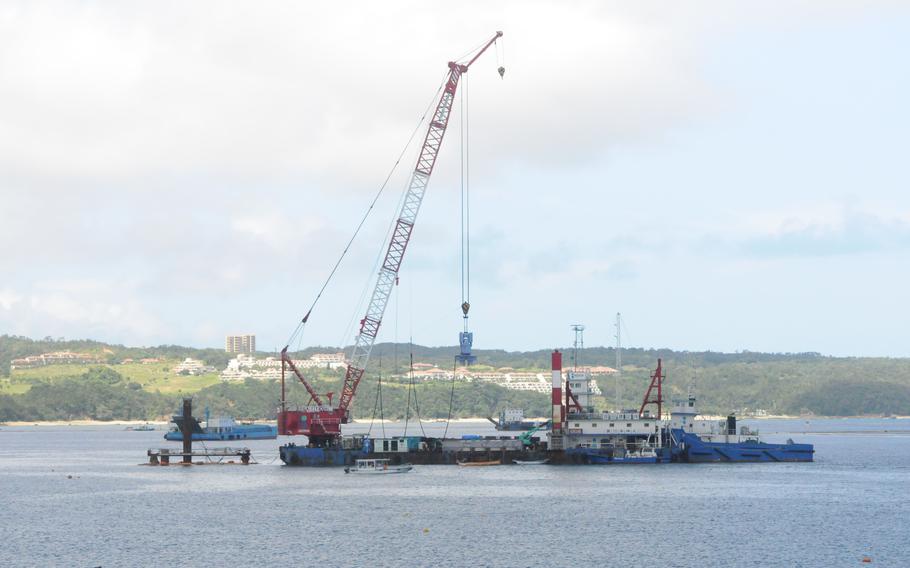
A crane used to drive test piles floats in Oura Bay at the site of a future U.S. Marine Corps runway at Camp Schwab, Okinawa, Japan, July 9, 2024. (Keishi Koja/Stars and Stripes)
CAMP SCHWAB, Okinawa — Japan’s government this week began preliminary work on a seawall at the site of a long-delayed airfield for the Marine Corps.
Contractors on Monday drove test piles into the soft seabed of Oura Bay, Japan’s Chief Cabinet Secretary Yoshimasa Hayashi said during a news conference that day. The test piles will prepare the site for steel pipes that support the seawall, he said.
“It is necessary to drive test piles before starting the seawall construction, to be able to conduct it safely and smoothly,” Hayashi said.
A floating crane used to drive the test piles into the seabed worked in the bay Tuesday. The Okinawa Defense Bureau did not respond Tuesday to a phone call seeking comment.
The bureau told the prefecture’s Seashore Disaster Prevention Division that the vessels would enter the bay July 1, but the actual work appeared to have begun Monday, a division spokesman said Tuesday by phone. Some Japanese officials may speak to the media only on condition of anonymity.
The division asked the defense bureau to refrain from starting work at Oura Bay until discussions were complete. However, driving the test piles is “not subject to the detailed design discussions because it is not part of the seawall constructions,” Hayashi said.
“The government is saying that is a test but considering the impact to the environment, this pile driving is part of the construction,” the division spokesman said.
Japan’s Ministry of Defense investigated damage to coral in the bay July 4 caused by the anchor chain of one of the vessels later used to drive the test piles, Hayashi said.
The airfield being constructed on Camp Schwab on reclaimed land is meant to replace Marine Corps Air Station Futenma, located in densely populated Ginowan city. The U.S. and Japanese governments agreed to move the base in 1996, but construction of the new site in the Henoko area has been repeatedly delayed by the Okinawa prefectural government.
The construction zone at Schwab is divided into two main sections: 279 acres on the base’s north side and 91 acres in the south, according to the prefecture’s website. Work on the Oura Bay side, or north side, had been on hold since April 21, 2020, when Okinawa Gov. Denny Tamaki, citing safety and environmental concerns, refused to approve design changes meant to solidify the soft seabed.
Tamaki filed, and lost, three lawsuits, culminating in a September loss at the Supreme Court. Japanese Minister of Land, Infrastructure, Transport and Tourism Tetsuo Saito approved the construction permits Dec. 28 after Tamaki ignored a Dec. 25 deadline from Fukuoka High Court. The court handed Saito that authority if Tamaki refused.
Hayashi in January announced that work to reclaim land from the bay would resume. The Okinawa Defense Bureau in June notified the prefecture that work in Oura Bay would start in August.
Movement of quarried material to the site was halted early this month after a truck hit and killed a security guard and injured a protester at the port of Awa.